|
Dahlias in Plant Genetics, Biology 138
2008 Lab Exercises and Potential Questions
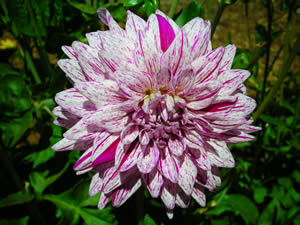
Dahlia 'Blackberry Ripple', a purple and white variegated informal decorative type
Dahlias in Plant Genetics Lab, Biology 138
Dahlias exhibit tremendous diversity of floral and leaf form as well as anthocyanin pigmentation hue, intensity, and pattern. There is little formal genetic analysis of this fascinating species – we will make a start on answering basic questions about the genetic and environmental regulation of plant color and structure in our lab.
Materials: You’ll have 6-12 dahlia varieties for the initial lab exercise, and for later labs there are additional examples of these varieties (and you can trade varieties with other students to “specialize” in analysis of certain types).
Photography: Photos are a primary source of data in this lab. A class digital camera will be available; faculty and TA will also bring cameras, and if you have a camera, please use it. A card reader will transfer your pictures to the class MAC. To provide tips on capturing dahlia images, professional photographer Frank Avril will join us during the labs to help you capture your data. View his website here. Additionally, Mr. Avril has written some guidelines for picture taking:
Recording Data and Photographs: Each person should keep a lab notebook folder on the lab computer at the greenhouse. Take photos of everything interesting and put them into your folder. These folders will be “backed up” periodically onto the class WIKI and Coursework. Pooled class data will be in a class folder. You can e-mail yourself materials you need to write you lab reports.
Mug Shots: We’ll be taking everyone’s picture to post on the WIKI. Mug shots of the dahlia varieties are available already here; feel free to have a look at multiple means of sorting these images.
Video: Stanford media specialist Kim Hayworth will also be available to provide advice on making movies (youtube-style), sound recording, etc. Click here to see last year's videos.
Lab Organization: Learning to design data sheets to collect/collate information is a key part of science. For each lab, we will briefly discuss what needs to be recorded, but you are responsible for “designing” the data collection and statistical treatment. You may work in groups in the lab as long as each person prepares an independent lab report. In the first few labs we will pool some of our data from the whole class to get more “robust” numbers on the regulation of anthocyanin pigmentation and on plant growth; these common data can be used to formulate better individual projects later in the course.
Formal Lab Reports should include the following:
- Introduction and objectives, including a brief summary of a related experiment in the published literature, and succinct statement of your hypothesis or goal.
- Results, including experimental set-up with drawing or photo labeled as a Figure.
- Tabular data including statistical treatments.
- Pictures to illustrate range of data types, your conclusions, labeled as Figures.
- Conclusions, including answering questions such as: Did you validate your hypothesis and how do you know that? What you would do differently next time?
- Ideas for a follow-up experiment with citations of other relevant papers.
- References (at least one or two published papers on the general subject of your experiment).
- Acknowledgments to those who assisted you in your work.
Reports should be finished within two weeks of starting a lab. Lab Reports should be “turned in” on the Class WIKI, more information about which will be given at the inception of class. Reports will be graded. If necessary, the report will be returned to you with questions that must be addressed before the grade is given, i.e. to clarify an ambiguity in the experimental procedure.
Grading
Formal Genetic Analysis: You are encouraged to perform crosses between specific varieties; we’ll harvest and grow your F1 seed for you and let these plants self-pollinate. Some F1 crosses from previous years will be available in class for evaluation. As this lab is given in successive years, we’ll build up many crosses for evaluation to make conclusions about the dominance of genes controlling specific traits.
Publishing Results: The long-term goal is to publish papers analyzing the genetic and environmental control of dahlia anthocyanin, leaf shape, and floral form in the standard scientific literature. Everyone who contributes data that are well-supported with replicates and controls will be an author. In addition, material will be edited for content and combined with other authors to augment this website.
The syllabus from the 2008 class follows:
Date |
Activities |
April 2 |
- Tour of greenhouse lab --- 184 Stockfarm Road. Safety training.
|
April 9 |
-
Is anthocyanin pigmentation regulated coordinately between the flower, stem and leaves? Class will pool observations into one table during the lab.
-
Experiment 1: manipulate dark vs. light to determine something about light-induction of stem anthocyanin pigmentation in five dahlia varieties. Take photographs of your plants and of the experimental set-up and load into your computer file on the wiki
-
You will need to return to score the results after 1 or several days as well as 7 days later.
|
April 16 |
-
Brief reports on Experiment 1 conclusions.
-
Experiment 2: manipulate light quality and score anthocyanin in stem, leaf, and/or flower in several varieties; use replicated samples of each chosen variety.
-
Count the number of petals in 5 varieties of dahlia for pooled class data. Are petals symmetric? Is the flower symmetric? In what ways is each floral form distinctive?
|
April 30 |
- Brief reports on Experiment 2 conclusions.
- Experiment 3: manipulate light, temperature and/or metal ion application to test the impact on anthocyanin pigmentation on varieties with bicolored (such as those found in Union Jack) or variegated flowers (such as those found in Blackberry Ripple and Dixie’s Winedot) .
- Discuss how to do a clonal analysis of Blackberry Ripple; number the flowers on several plants (including flowers per stem) and start recording pigmentation patterns.
|
May 7 |
- Brief reports on Experiment #3 conclusions.
- Experiment 4: formalize the Blackberry Ripple clonal analysis and compare transposon action to bicolor flower “patterns” before and after environmental manipulation.
- Does transposon timing or frequency change with the environment?
|
May 14 |
- Brief reports on Experiment 4 conclusions.
- Individual project.
|
May 21 |
- Brief reports on the design of your Individual project.
|
May 28 |
|
June 4 |
- Clean up lab.
- Plant extra dahlias outside.
- Party!!
|
Some additional questions to consider:
The anthocyanin pathway, duplicate genes, and testers
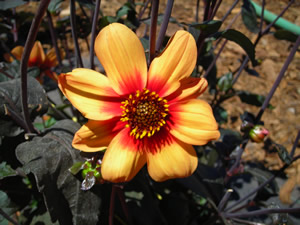
Dahlia 'Moonfire' with dark stems
-
Does floral pigmentation correlate with leaf and stem pigmentation? Principle from class: in corn duplicated genes regulate anthocyanin production with typical alleles of R, C1 working in the aleurone and edge of first leaf and anthers while typical alleles of B (duplicate of R), Pl (duplicate of C1) work in the leaves and stem.
Students will be able to observe stem and leaf color in the greenhouse and observe floral pigmentation on the web site. Do plants with purple, red, pink, orange flowers have purple stems and leaves? Do white and yellow flowers correlate with green stems and leaves?
-
What are the differences in the pigments found in dark purple, lavender/purple, red, orange, pink, yellow and white flowers? Based on knowledge of the pathway in corn and Petunia and that "true blue" pigment requires the most enzymes, what are the likely defects (missing functions) in the purple flowers? Red? Orange? Yellow? White? Consult the pigment spectra on the web site for some clues.
View a meta-report from 2008 data on metal ion control of flower color.
-
How do you name colors? How can the color card system be used to make a regular assignment of color?
If you want to pursue more about pigmentation, consider designing more experiments for your individual project. Perhaps you'll want to take spectra over time to assess where and when pigment is being accumulated? Or observe cells in a microscope to note where the pigment accumulates.
The impact of environment on gene expression
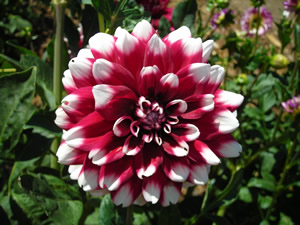
Dahlia 'Duet' with bicolor flowers
-
-
Do any of your varieties produce bi-colored petals? If so, what is the pattern? What about other students? What are all the different patterns you can find on the web site? In class, let's discuss hypotheses to explain these patterns and formulate some experiments to test them?
Something to think about: How will you "stage" floral buds to understand when in development you are applying a treatment?
If you want to pursue more about pigmentation, consider designing more experiments for additional labs.
Color and variation in petals

Dahlia seeding 04TS10 showing transposon activity
-
What distinguishes between a genetic pattern, a pattern imposed by the environment, and a pattern generated by the action of a transposable element? Consult the range of bi-colored petal types again. Could you classify these as genetic, environmental, and transposon-induced by your criteria?
View a meta-report from 2008 data on transposon genetics.
-
For a transposon pattern how would you answer the question of whether the frequency of transposon excision is constant over petal development? What measurements would you need? How would you plot it? With your group, decide on a plan and collect the data.
If you are interested in clonal analysis, you might design more experiments to understand more about dahlia growth, i.e. the likely number of cells in a shoot apical meristem, the number in a bud meristem, etc.
Floral type
         
     
Scroll over each thumbnail for its floral type
-
How many floral types are recognized by dahlia breeders? Consult the web site the learn the names and then classify your set of materials and compare with other students.
-
-
Do some flowers have floral parts that are "in between" the recognized four organs, i.e. petalloid stamens? If so, where are these structures? For varieties that have them, are they the same in each variety?
Leaf shape
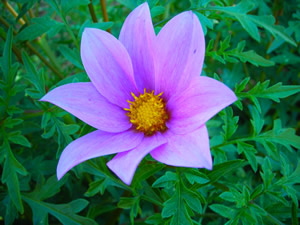
Dahlia 'Woodbridge' with highly dissected, even pinnatafid foliage
-
Do dahlias have leaves or leaflets? What types of leaves shapes are found in your set of dahlias? In the entire class? On the web site?
-
How would you explain the differences in leaf shape?
-
Is there any correlation between leaf and petal shape? Do you think the same genes determine petal size and leaf size? Stiffness? Shape (indented or smooth margin?) etc.
Individual Projects
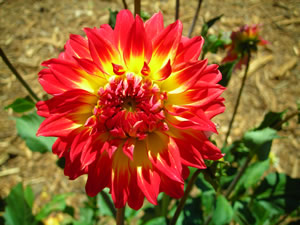 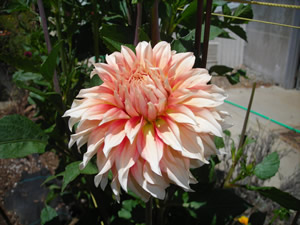
The future? Dahlia 'Rock Run James'
with a pink branch sport on the right, and the normal form on the left
Design your own experiment or a group experiment to
probe pigmentation or floral form more critically.
|



